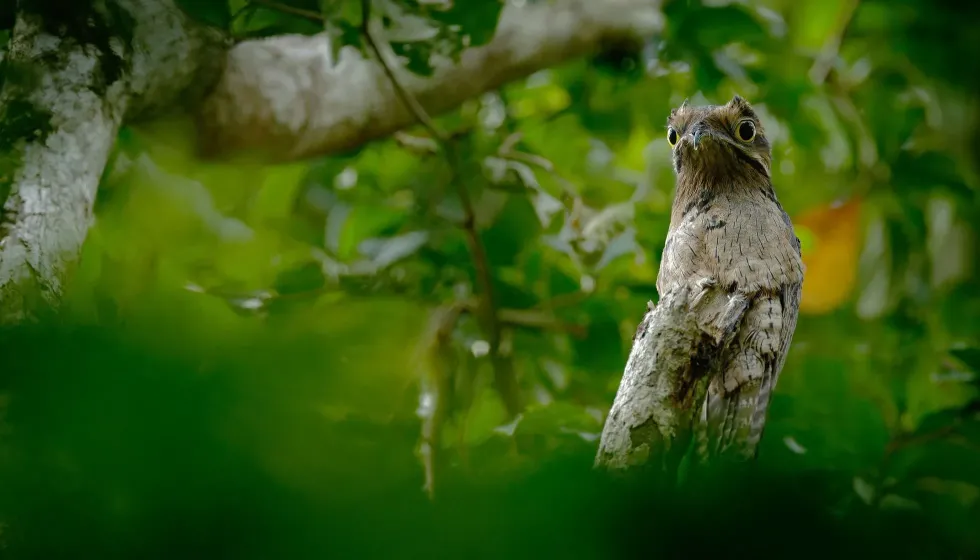The common potoo is a bird that has misled ornithologists for decades. It is one of the seven potoo species and this bird is highly elusive by nature.
One has to pay close attention to see this bird sitting on a branch, perch, or stump in the forest. This bird is nocturnal and it is traced at night either by its huge eyes glinting in the dark or by its hauntingly beautiful call.
It is a whistle that may sound like 'poor, me, all, alone'.
It is a master at blending itself into the forest. However, human activities are causing habitat loss and the numbers of these birds may not be concerning now, but continual habitat destruction may lead to a sharp decline in the population of these birds.
Though the name is common, a search for this bird in the jungles of Central America can tell you how uncommon it is to spot one atop a perch! As it is so elusive and hard to spot thanks to its camouflage, its behavior is a mystery.
Carry on reading if you are enjoying reading facts about this intriguing bird. If you like reading about this bird, you may also like reading about blue-and-yellow macaw and song thrush.
Common Potoo Interesting Facts
What type of animal is a common potoo?
The common potoo is a bird that belongs to the phylum Chordata, order Caprimulgiformes, and species N. griseus.
What class of animal does a common potoo belong to?
The potoo belongs to the class Aves, which comprises birds.
How many common potoos are there in the world?
The approximate population size of these birds is 500,000-4,999,999, however, the trend is exhibiting a decline in their numbers.
Where does a common potoo live?
The potoo bird's habitat includes open woodlands with trees and savannahs. According to the IUCN, it is found in the terrestrial biome ecosystem and the realm is neotropical. It is found sitting in branches of trees and camouflages itself against the branches. This kind of mimicry helps it to hide in plain sight.
What is a common potoo's habitat?
Potoo birds are found in Central America and South America. It is found in Argentina, Brazil, Costa Rica, Panama, Peru, and several other Latin American countries. It is found from northern Nicaragua to southern Uruguay. These birds can also be found in Jamaica and Hispaniola in the Antilles.
Who do common potoos live with?
Potoo birds are solitary by nature. However, they may be seen in pairs in the breeding season.
How long does a common potoo live?
It is believed that the potoo bird lives for around 12 to 14 years. However as it is a highly elusive species, the exact details are not known.
How do they reproduce?
The common potoo bird is monogamous and mates with the same partner throughout its life. In the breeding season, females lay a single egg on the branch of a tree, a tree stump, or a hollow.
A unique feature about these birds is that they do not build a nest to lay their egg in but rather a stump or another part of the tree acts as a nest. The egg is white with spots.
Both parents incubate the egg for 30 to 35 days and the young one slowly learns how to adapt to the environment. The parents look after the juvenile for only a few days.
When protecting their young ones, these birds are highly cautious and respond to the slightest of sounds. Their body posture seems erect when they are cautious and they relax slowly only after the threat has passed.
What is their conservation status?
According to the International Conservation of Nature(IUCN), the conservation status is of Least Concern, meaning that their population is not in any immediate danger. However, this bird species is facing habitat loss which could cause problems for the population of common potoos.
Common Potoo Fun Facts
What does common potoo look like?
This bird has distinct black, white, gray, and molten red-brown plumage. It has a small beak, a wide mouth, and huge yellow eyes with black eyeballs. The eyes highly reflect artificial light. It is a master of camouflage.
Its wingspan is 33-37 in (84-94 cm). There are slight notches in its eyelids which helps it to see even with its eyelids closed. What an amazing, subtle adaptation that helps it to keep an eye on potential predators.
How cute are they?
Common potoos are often called comical for their appearance and may not be termed as cute.
How do they communicate?
The call of a potoo bird is a strange one and drops slowly in pitch and volume. Often, the call is termed as haunting like in Peru.
The strange call is a melancholic 'bo-ou, bo-ou, bo-ou, bo-ou, bo-ou'. When seized it produces a squeaky sound like a crow.
It is the call of this potoo that helps ornithologists find them, however, in the forest suddenly hearing the call of a potoo gives an eerie feeling. It is said that the call of the great potoo is not for the faint-hearted and scares people especially if they are not accustomed to hearing it.
Potoos sing in the morning, evening twilight, and by moonlight. It mostly sings during the drier part of the year which coincides with its breeding season.
How big is a common potoo?
The common potoo bird is 14-16 in (34-38 cm) in length and is relatively smaller in size compared to the great potoo which is 18-23 in (45.7-58 cm) in length.
How fast can a common potoo fly?
The potoo can fly moderately fast and usually does not fly during the day. Their flight is swift and direct and it beats the air with its large wings methodically.
How much does a common potoo weigh?
The common potoo weighs around 5.6-6.7 oz (160-190 g).
What are the male and female names of the species?
Males and females of this bird species look strikingly similar and have no distinct names.
What would you call a baby common potoo?
A baby common potoo may be called a chick or nestling.
What do they eat?
The potoo bird feeds mainly on insects and flying insects like flies, moths, cicadas, beetles, grasshoppers, ants, flying mantises, and small vertebrates. It is mainly an insectivorous bird.
Are they dangerous?
Potoos are rather shy and skittish.
Would they make a good pet?
The potoo bird is essentially wild and is reclusive by nature. They do not even stay close to other potoos, so they can't be considered as pets.
Did you know...
The great potoo is the biggest of the potoos reaching up to 24 in (60 cm) in height. Like the common potoo, the great potoo is also an insectivore.
A great potoo is believed to be a sad spirit of a woman who could not follow her husband to the moon and was left behind on Earth. It believed that its calls are the cries of the woman.
This is a legend amongst the Shuar people of Ecuador. The common potoo can be distinguished from the great potoo by its black mustache stripe.
The potoo bird is real and is a genuine bird species. It is not merely a photoshopped image of a bird as is often thought to be because of its eyes.
Potoo birds are also called 'poor-me-ones' and in Spanish, they are called Nictibio Comú.
They sleep during the day and are awake at dusk. They are known as Urutaú.
Common potoos were recently divided into two groups. Potoo birds that are found in Mexico, Costa Rica, and Jamaica are now called northern potoos as they are considered to be different based on their distinct calls.
Is a common potoo an owl?
The potoo is a relative of the owl and is a mix of the nightjars and frogmouths. Like owls, these potoos are hunters at night and are lazy during the day.
Can common potoo be a prey?
The potoo can fall prey to larger birds and monkeys. The nests of a great potoo can fall prey to collared forest falcons, mantled howler monkeys, and white-headed capuchins.
Here at Kidadl, we have carefully created lots of interesting family-friendly animal facts for everyone to discover! Learn more about some other birds including wood thrush or Gouldian finch.
You can even occupy yourself at home by drawing one on our Common Potoo coloring pages.









